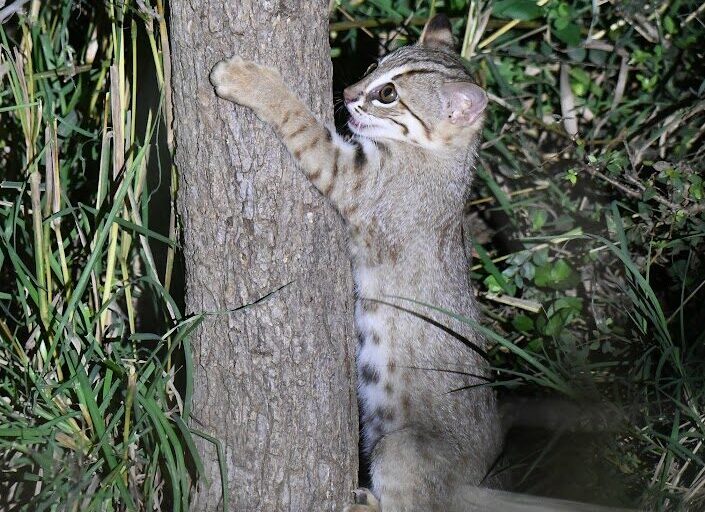- Authorities are planning to set up 100 camera traps over 29 sq.km. in Keoladeo National Park to study the rusty-spotted cat and develop conservation strategies.
- India is home to 80% of the rusty-spotted cat population. However, the elusive species, that thrives in deciduous forests, scrub lands and agricultural land holdings, is not well studied.
- About 75% of the cat’s habitat range in India and Nepal is at risk of land conversion.
Park authorities of the Keoladeo National Park in Bharatpur, Rajasthan are actively preparing monitoring strategies after a rusty-spotted cat (Prionailurus rubiginosus), was photographed carrying its kitten in the park last month.
Manas Singh, Deputy Conservator of Forests (Wildlife), Bharatpur National Park and Director, Keoladeo National Park, told Mongabay India that it was the first sighting of the species in the last five years and the first in 10 years of a mother with kitten. It is perhaps an indication that Keoladeo is a suitable habitat for the species, Singh noted.
The elusive small cat
The rusty-spotted cat is small in size, weighing about 1 to 1.6 kilograms. With brownish-grey fur tinged with rufous tones and white undersides, the small cat is known to be shy and elusive. This, coupled with the lack of a comprehensive census of its population, make it difficult to discern the species’ population trend.
It is categorised as ‘near threatened’ in the IUCN Red List of threatened species. It has also been given the highest level of protection under Schedule 1 of the Wildlife Protection Act, 1972, in India and under Appendix I of CITES (Convention on International Trade in Endangered Species of Wild Fauna and Flora).

After the two visitors photographed the cat in Keoladeo last month, park authorities decided to monitor the presence of the cat more closely and learn about its behaviour to better design conservation strategies. The park authorities have set up 40 camera traps in a 29 sq.km. area and are planning to install 50 more.
“The large number of camera traps will allow us to study the behaviour of the species, estimate its population and design conservation measures to protect it,” said Singh.
Dwindling habitat and conservation measures
Besides Keoladeo National Park, the rusty-spotted cat has been sighted in many parts of Rajasthan including Sajjangarh Biological Park, Phulwari ki Nal Wildlife Sanctuary, Jaisamand Wildlife Sanctuary in Udaipur, Sita Mata Wildlife Sanctuary in Pratapgarh and Bassi and Bhainsrorgarh Wildlife Sanctuaries in Chittorgarh, among others. Its presence has also been found in other districts of the states such as Baran, Pali, Sawai Madhopur, Alwar, Kota, Bundi, Jhalawar, Dholpur, Bharatpur and Sirohi.
The species prefers deciduous forests, scrub lands and agricultural land holdings. Shomita Mukherjee, Principal Scientist, Sálim Ali Centre for Ornithology and Natural History (SACON) told Mongabay India that the southern part of the Deccan region and catchment areas in Gujarat, areas near Eastern Ghats and in the Himalayan foothills are other suitable habitats for the rusty-spotted cat. The cat tends to avoid extreme habitats, such as extreme hot or cold deserts, or regions with excessively high rainfall like the northeast parts of India.

Globally, the rusty-spotted cat population is limited to India, Nepal and Sri Lanka. The species is now threatened by habitat loss due to land-use change and deforestation. According to the IUCN, 75% of the habitat in the current distributional range of the cat, in India and Nepal, is facing an imminent danger of land conversion, which might lead to a 20-25% decline in its population in the next three generations. While there may be potentially other threats to the species, there is not enough evidence about it, given that the species is poorly studied.
“Many individuals reside outside protected areas, which are such a small proportion of our geographical land. The problem with most species now is they’re forced to live in areas that are not their prime habitats. We’re testing the boundaries of their tolerance, beyond which they will not survive,” said Mukherjee.
She added that India is home to about 80% or more of the world’s rusty-spotted cat population. “This puts a responsibility on us to actually save the species,” she said.
Conservation measures
For conservation of the species in Keoladeo, DCF Singh plans to work on a more holistic approach, starting with habitat protection.
“Our idea is to protect the habitat from degradation and limit human activities as far as possible. With around 100 camera traps in a 29 sq.km. range, we will be able to study the species’ relationship with its environment. If we find any new habitats, like wetland ecosystems, that support its population, we will further reduce the human imprint to ensure habitat conservation,” he told Mongabay India.
Mukherjee, however, said she feels that installing 100 camera traps in a small area might disturb the habitat and prove to be detrimental to the cat’s population and habitat.
“Target three of 23 of the Global Biodiversity Targets adopted in December 2022 during the Kunming-Montreal Global Biodiversity Framework at COP15 in Montreal, Canada, states that parties will protect 30% of the terrestrial, inland water and coastal and marine areas by 2030. This [habitat preservation] might be a big step in conserving the population of the rusty-spotted cat, along with other small carnivores,” she said.
Banner image: The rusty-spotted cat, often known as the hummingbird of cats, is a small and agile cat that is categorised as near threatened in the IUCN Red List. Photo by Radheshyam Bishnoi.
